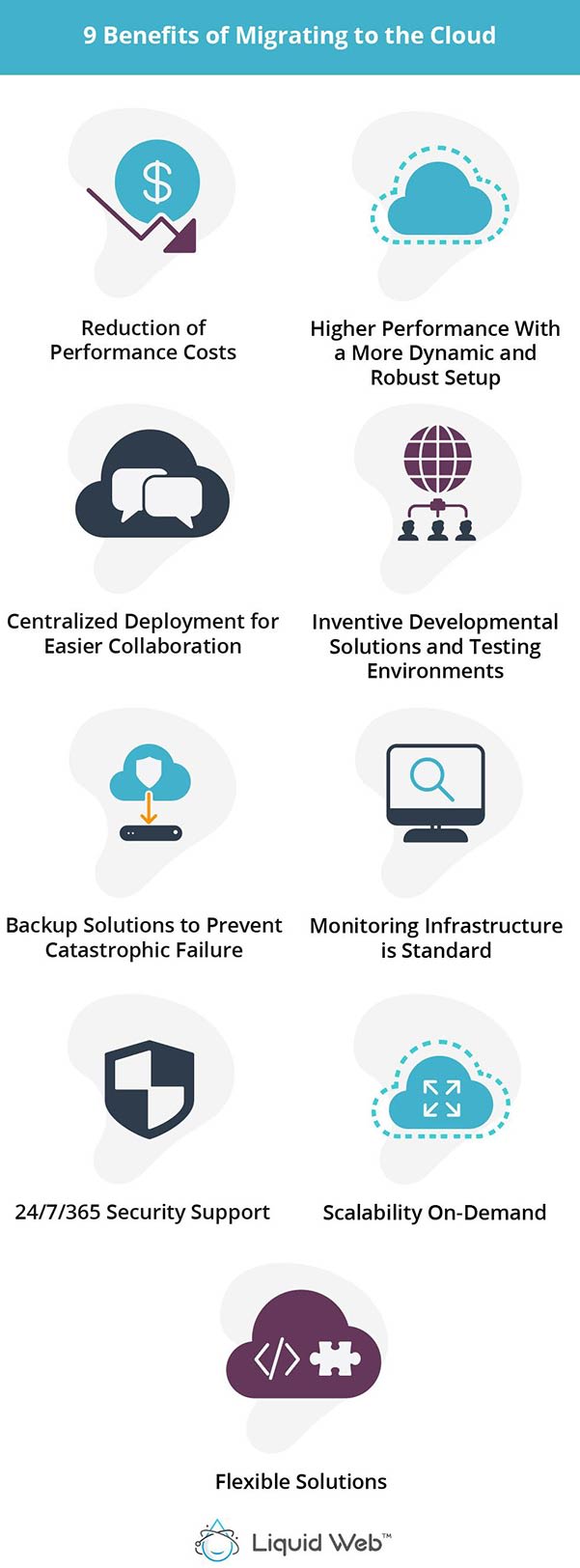How to Plan a Cloud Migration Project
The mere thought of migrating to the cloud can cause stress and anxiety. From lost data to compromised security, the potential problems associated with a cloud migration can make even the most skilled IT team start to sweat.
But migrating to the cloud hosting be a straightforward process where risk is minimized when success is planned for. This checklist will help you understand what steps to take to migrate to the cloud, ensuring that your next cloud migration is an opportunity to improve your business, instead of something to fear.
What is a Cloud Migration?
Cloud migration is the process of moving workloads and applications into a cloud hosting environment. This migration can be moving from traditional web servers or hosting infrastructure into the cloud. It can also be from one cloud to another.
The target cloud environment can be a public cloud, private cloud, multi-cloud, or hybrid cloud.
Usually, the decision to move to cloud infrastructure comes to escape legacy infrastructure. This is typically a natural progression for many companies, and migration is seriously considered when the cost of maintaining failing infrastructure is higher than a migration to hardware maintained by hosting service providers.
A Summary of Your Cloud Migration
The process of migrating from traditional web servers and hosting infrastructure to the cloud often begins with an audit that identifies current applications, data sets, and security and privacy risks. These risks then need to be mitigated before the migration begins.
Next, the right cloud infrastructure for your needs should be selected. Your new cloud environment will need enough processing power and storage space to handle your current workloads as well as future growth projections. The cloud provider's pricing model can then be evaluated in order to find the best price that matches your budget and system requirements.
Decisions need to be made about cloud security and compliance, including the cloud provider's metering policies, where data will reside (public cloud or private cloud), permissions settings, encryption options, and more.
Once these decisions are finalized and you're ready to move forward with a migration project plan that includes all of your requirements, the cloud migration project can begin.
It cannot be overstated: a cloud migration without a clear and understood project plan will take longer and cost more than a migration that has been well-planned for.”
Creating the migration project plan means:
- Detailing each part of the existing infrastructure.
- Which of those parts will be migrated and to where?
- What will happen to unneeded assets or unused infrastructure after the migration?
This migration project plan should be shared with each stakeholder and ample time should be given to take in feedback and make any necessary changes to the plan.

9 Benefits of Migrating to the Cloud
With so many reasons to move to the cloud, here is a list of nine of the most prevalent benefits that will come from migrating to the cloud:
1. Reduction of Performance Costs
Without the overhead of maintaining an existing on-premise setup, you could see a drop in overall cost switching to cloud computing. Many hosts provide cloud plans on a pay-per-use basis, while others, like Liquid Web, provide lock-in monthly rates for predictable billing.
2. Higher Performance With a More Dynamic and Robust Setup
With the ability to scale new and existing environments, development, testing, and deployment become increasingly adaptive.
3. Centralized Deployment for Easier Collaboration
Centralized deployment brings a heightened collaboration to projects that require a meeting of the minds.
4. Inventive Developmental Solutions and Testing Environments
With entire networks protected by VPN, you can create whatever type of network is needed to accomplish any number of tasks and goals.
5. A Myriad of Backup Solutions to Prevent Catastrophic Failure
Cloud infrastructure comes with on-server backups, off-server backups, offsite backups, and disaster recovery options. Even if the server somehow disappeared altogether, a copy can be deployed in a matter of minutes. This effectively prevents the majority of catastrophic events and hacking attempts, even if your system is compromised.
6. Monitoring Infrastructure is Standard in Cloud Computing
Monitoring infrastructure means watching ports, pings, packets, traffic, hits, hacks, whatever. It’s monitored and if there’s ever a problem, you’ll know right away.
7. Outsourcing Security to a Team of Dedicated Professionals
Liquid Web has staff 100% of the time, 24/7/365. Support is available whenever needed and ready to analyze anything that could be considered a threat.
8. Scalability On-Demand
Increase the server capacity for large events or holidays like Black Friday, and then scale back to normal size for business as usual. With a cloud environment, it’s just a few clicks away and easier than ever.
9. Flexibility to Invent New Solutions for Any Circumstances
Want to test what it would be like to have a dedicated server or dedicated database server? Need to see how much more performance you could get without mail on the web nodes? You can test all of this with cloud servers, and more.
Your Ultimate Cloud Migration Project Plan Checklist
Now that you understand how to successfully migrate to the cloud at a high level and know the benefits, it is time to outline the details necessary for the process itself. This checklist should help you understand not just what to do when it comes to cloud migration, but also why those individual activities are important in making the migration a success.
1. Inventory All Assets, Applications, and Datasets
Make sure to take the time to inventory all of your cloud-bound assets, applications, and datasets before you migrate them over. You'll want to get a detailed list of everything being migrated so that you are aware of what needs to be moved for cloud migration.
Key Questions to Consider:
- How much space will these assets require?
- How much processing power or RAM?
2. Perform An Audit and Identify Current Security Risks to Mitigate Before Migration
In cloud migrations, it is important to identify and mitigate security risks. These risks can be software-related or physical in nature.
Risks to data in transit, risks in integrating applications, and risks to business continuity both during and after the migration should all be taken into consideration.
Even more, detailing these risks and communicating them with stakeholders in the migration can help reduce and even remove the chance of negative events during the migration.
Key Questions to Consider:
- What is the backup strategy of the new environment?
- What kind of hardware or software firewalls should be implemented, and what access is needed for different users?
- How will data be exposed and transferred between the enterprise architectures?
3. Plan for and Test the Cloud Migration Project
Planning for the cloud migration project is a necessity. Further, testing the plan before embarking on the migration itself is important for success.
Testing the plan is about going through possible scenarios and optimizing for the desired outcomes. A few extra minutes of finding the flaws in your migration project plan goes a long way in making sure the live migration is successful.
Key Questions to Consider:
- What are the expected outcomes of each part of the migration?
- What are the threats to those outcomes?
- Can those threats be removed, making the plan even better?
- Who will execute each step of the plan, and what third parties need to be notified?
4. Choose the Right Infrastructure
Choosing the right cloud provider is about more than just cost savings and improved efficiency once your migration is complete. You also need to choose a cloud provider that makes migration and onboarding as simple as possible. This includes automated deployment and orchestration, cloud scalability, cloud elasticity, cloud storage, and cloud monitoring.
Having your new infrastructure properly set up is a critical part of a successful migration.
Key Questions to Consider:
- How much support is the provider able to offer during your onboarding, and what kind of emergency assistance do they offer?
- How will cloud servers be delivered, and what kind of tuning or setup will be needed for full performance?
Other considerations may include identifying data volumes to migrate based on cloud provider capacity limits, understanding public versus private cloud restrictions, and compliance requirements including HIPAA or PCI DSS regulations.
Keys to a Successful Cloud Migration
Whether you are migrating to a public cloud environment like Cloud Server Hosting or choosing a Private Cloud powered by VMware, your server migration will be successful if you consider the following cloud migration best practices:
- Select cloud infrastructure that can handle current workloads and future growth projections while also meeting your requirements for security.
- Determine if the cloud provider you have selected is acceptable from a compliance perspective based on your organization’s needs.
- Ensure all third-party resources are properly accounted for and considered as part of the transition process.
- Determine cloud migration readiness by discussing cloud readiness with IT teams and stakeholders to ensure cloud adoption is not happening too early or too late in the technology lifecycle.
- Establish a plan for migrating workloads, applications, data, storage infrastructure, and other elements related to your organization’s cloud environment.
- Share information about cloud migration plans with cloud providers and contract cloud migration services as needed.
- Conduct a final review before migrating to the cloud, including consideration of any third-party or provider-managed resources that were not accounted for in the initial cloud readiness assessment. This is also when you should engage service-level vendors such as backup or antivirus providers.
- Document all cloud migration activities and agreements.
- Complete cloud migration, including final testing to ensure the environment is functional.
If your organization is undergoing a complete digital transformation or simply looking for a hand in adding new cloud workloads, the professional services team at Liquid Web can help.
Migrating to the cloud can be a big undertaking, but it doesn't have to be as difficult as you might think. With the right planning and execution of your cloud migration project, you will find that migrating from traditional web servers or hosting infrastructure is easy and worry-free.
We hope this post has given you some valuable insights into what considerations need to go into a successful cloud migration so that yours goes just as smoothly! Ready for Liquid Web's assistance? Reach out anytime for additional information about the cloud services we offer or if you are interested in partnering with us on your next digital transformation initiative.

Andrej Walilko
Andrej Walilko (RHCE6) is a seasoned Linux Administrator, and he is a Migration Project Manager at Liquid Web, developing specialized processes for complex migration types. He enjoys doing woodworking, home improvement, and playing piano in his free time.
Keep up to date with the latest Hosting news.



